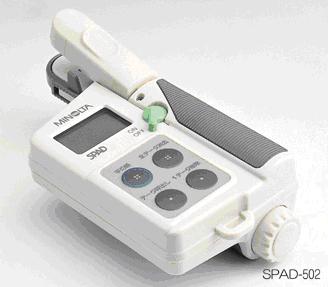According to the absorption of the chloroplast pigment extract to the visible spectrum, the spectrophotometer is used to determine the optical density at a specific wavelength, and the content of each pigment in the extract can be calculated using the formula. The spectrophotometer uses a light source that can generate multiple wavelengths and passes through a series of spectrometers to generate a light source with a specific wavelength. After the light source passes through the tested sample, part of the light source is absorbed and the absorbance of the sample is calculated, thereby converting the sample into a sample. concentration. The absorbance of the sample is proportional to the sample concentration.
According to Lambert-Beer law, the optical density D of a colored solution is proportional to the solute concentration C and the thickness L of the liquid layer, ie:
D=kCL. Where: k is the proportional constant. When the solution concentration is in percent concentration and the liquid layer thickness is 1 cm, k is the specific absorption coefficient of the substance. The specific absorption coefficients of various colored substance solutions at different wavelengths can be determined by measuring the optical density of known substances at different wavelengths.
If there are several kinds of light-absorbing substances in the solution, the total optical density of the mixed liquid at a certain wavelength is equal to the sum of the optical densities of the respective components at the corresponding wavelengths, which is the sum of optical densities. Determination of chlorophyll a, b, and carotenoid content in chlorophyll pigment extracts requires determination of the optical density D of the extract at three specific wavelengths, and based on the chlorophyll a, b, and carotenoids at that wavelength. The specific absorption coefficient can be found its concentration. In the determination of chlorophyll a, b, in order to exclude the interference of carotenoids, the wavelength of the monochromatic light used is selected as the maximum absorption peak of chlorophyll in the red region.
It is known that the maximum absorption peaks of 80% acetone extracts of chlorophyll a and b in the red region are 663 nm and 645 nm, respectively, and that at 663 nm, the specific absorption coefficients of chlorophyll a and b in the solution are 82.04 and 9.27, respectively. At the wavelength of 645 nm, 16.75 and 45.60, respectively, can be listed according to the principle of additivity:
D663 = 82.04Ca+9.27Cb (1)
D645 = 16.75Ca+45.60Cb (2)
D663 and D645 in formulas (1) and (2) are the optical densities of chlorophyll solutions at wavelengths of 663 nm and 645 nm, and Ca and Cb are the concentrations of chlorophyll a and b, respectively, in mg/L. Solve the equations (1), (2), get:
Ca = 12.72D663 C 2.59D645 (3)
Cb = 22.88D645 C 4.67D663 (4)
Add Ca and Cb to get the total amount of chlorophyll (CT):
CT = Ca + Cb = 20.29D645 + 8.05D663 (5)
In addition, since the absorption peaks of chlorophyll a and b at 652 nm intersect, both have the same specific absorption coefficient (both at 34.5). The total optical density (D652) can also be measured at this wavelength to determine the total amount of chlorophyll a and b. :
CT = (D652 × 1000) / 34.5 (6)
In the presence of chlorophyll, the content of carotenoids in the solution can be measured simultaneously by spectrophotometry.
Lichtenthaler et al modified the Arnon method and proposed a calculation formula for the content of three pigments in an 80% acetone extract:
Ca = 12.21D663 C 2.81D646 (7)
Cb = 20.13D646 C 5.03D663 (8)
Cx・c=(1000D470 C 3.27Ca C104Cb)/ 229 (9)
Where: Ca, Cb are the concentrations of chlorophyll a and b, respectively; Cx and C are the total concentrations of carotenoids; D663, D646 and D470 are the optical densities of chloroplast pigment extracts at wavelengths 663 nm, 646 nm and 470 nm, respectively.
Due to the difference in absorption spectra of chloroplast pigments in different solvents, the calculation formula is different when using other solvents to extract pigments. The wavelengths of the maximum absorption peaks of chlorophyll a and b in 96% ethanol are 665 nm and 649 nm, and the carotenoids are 470 nm. The following relationship can be listed accordingly:
Ca = 13.95D665 C 6.88D649 (10)
Cb = 24.96D649 C 7.32D665 (11)
Cx・c=(1000D470 C 2.05Ca C 114.8Cb)/ 245 (12)
Chlorophyll a can be measured either by on-line chlorophyll-a instrumentation or by laboratory fluorometric chlorophyll-a instrumentation. The chlorophyll fluorescence analyzer is more suitable for the determination of chlorophyll a in lakes and reservoirs. The Aquafluor handheld chlorophyll fluorescence analyzer from Turner Designs offers a choice of two channels: living chlorophyll a; blue-green algae (phycoerythrin or phycocyanin); turbidity; rhodamine WT; fluorescein; ammonium; Extraction of chlorophyll a.
The common type of chlorophyll meter only requires you to insert the leaves in the chlorophyll meter, and then you can see the value of chlorophyll content through the button, which is convenient and simple.

Chlorophyll analyzer
Adapter Sleeves are the most commonly used components for locating bearings with a tapered bore onto a cylindrical seat as they can be used on:
plain shafts
stepped shafts
They are easy to install and require no additional location on the shaft:
When used on plain shafts, the bearing can be located at any position on the shaft.
When used on stepped shafts together with an L-shaped spacer ring, the bearing can be accurately positioned axially, thereby facilitating bearing mounting and dismounting.
Adapter Sleeves
Adapter Sleeves,Bearting Adapter Sleeves,Adapter Sleeves For Inch Shafts,Metric Shaft Adapter
Ningbo Ritbearing Imp & Exp Co.,Ltd. , https://www.nbbearing.de